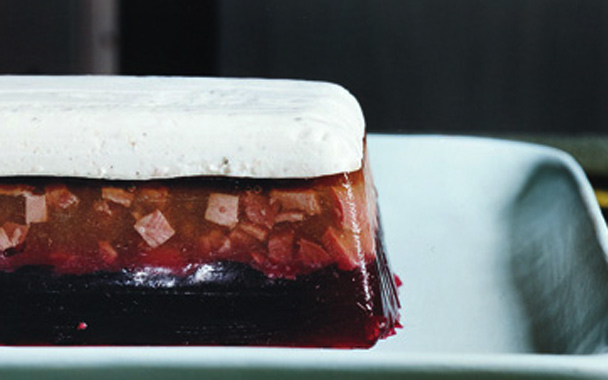You probably already know this, but it’s amazing what you can find doing a Google search. I live under a rock and don’t spend much time on the Internet; it just doesn’t come naturally to me. But I got on there because I needed to track down this specific bottled borscht for my Borscht Horseradish Terrine. All I remembered about it was that it had a gold St. Peter’s Basilica imprinted on its white label.
The terrine first came about after a research trip with test kitchen director Ruth Cousineau to Budapest, where we bonded over our Eastern European roots. (I’m half Russian.) We were bowled over by the history and varieties of sausages we found there, as well as the preserved meats and terrines made out of them. It was there I learned that there’s an incredible art to making really well-crafted terrines. When I developed my own for Gourmet, I used bottled borscht to make it easier for home cooks. And I particularly liked the borscht that came in the bottle with the gold and white label. To start, I picked up two different brands of bottled borscht, but neither resembled the jar I remembered. I made the terrine twice and felt disappointed. I went back to the drawing board—and to my computer.
I looked at the availability of different borschts online and stumbled onto Gold’s website. They make bottled horseradish and borscht, and among a number of products, I recognized that white and gold label on a jar of “Russian-Style Borscht.” I got off the computer and picked up the phone to ring Gold’s.
Within a minute, I was talking to the owner. No bells or whistles. It was great, like calling your neighbor who happens to run a food company. He told me that his Russian-style borscht is made with an unusually high percentage of beets, plus a lot of garlic, and that it would, as a result, be sweeter and more intense than other varieties. That was exactly what was missing from my terrine. And it’s a natural product, which is nice because it’s the clean essence of beets, not mucked up with a lot of additives. This borscht really made all the difference; it perfectly complemented the layers of bright horseradish sour cream and rich, jellied smoked veal tongue.
Using bottled borscht is a bit of a helpful shortcut for a dish that’s…okay, the terrine recipe isn’t hard, but it’s involved. But once you go through the motions, you see that it’s easy to do. Almost as easy as searching the Web.



 Pinterest
Pinterest


